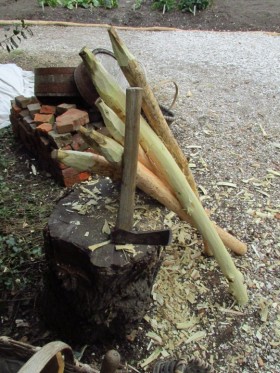The North American continent is blessed with perhaps the greatest diversity of herbaceous flowering plants of any place in the known world.
In particular, there is an almost incalculable variety of yellow ray flowers. Many of these plants grow quite large in their natural habitat and when they are brought into a garden with well manured soil their growth is truly prodigious; many growing 8 feet, 10 feet and even 12 feet tall. This great height makes them susceptible to blowing over during summer storms so we have fashioned a great device to hold them erect.
We begin with 5-foot sections of Black Locust poles.
Using a hatchet, one end is sharpened to a point and they are then driven into the ground amongst the plants early in the season before they start their growth. Black Locust poles commonly remain sound in the ground for 15 or 20 years and I am now at an age that I can say with some confidence that this is the last time I will have to accomplish this fairly onerous task.
Once the poles are pounded into the ground to a reasonably even height we obtain grape vines from a neighboring woodland and lay them across the tops of the poles, nailing several vines together on the top of each one.
As the plants grow up through the grape lattice they are accordingly supported in violent weather from toppling over.
The plants thus supported are:
- Giant Sunflower (Helianthus giganteus)
- Swamp Sunflower (Helianthus angustifolia)
- Spotted Joe-pye Weed (Eutrochium maculatum)
- Broad leaf Ironweed (Vernonia glauca)
- New York Ironweed (Vernonia noveboracensis)
- Tall Tickseed (Coreopsis tripteris)
- Cup Plant (Silphium perfoliatum)
- Rosinweed (Silphium trifoliatum)


Hi Wesley,
Back in December you and I were talking about my bay tree. The trunk has split. You recommended cutting it down and new growth would come out of the stump. I am curious as to the best time to cut the tree. Now or after danger of frost? I am in Southern Maryland.
Thank you,
Bryan
Dear Bryan,
I would cut it down sooner rather than later, it does not affect the survivability of the parent plant and the leaves are fresher for drying. In my experience the plant does not rejuvenate from the trunk but from root suckers around the trunk. If the plant is still alive you are likely to get a virtual forest of sprouts. I allow them to grow until the tallest is one foot high and then select the strongest and cut away the rest to form a single trunk tree. You may grow the Bay as a multi-stem shrub if you prefer. This is the second winter in a row that my Bay has frozen out so it will be instructive to see if it rejuvenates itself.
Kindly inform me of your progress,
Yr. obdt. Servant,
Wesley Greene